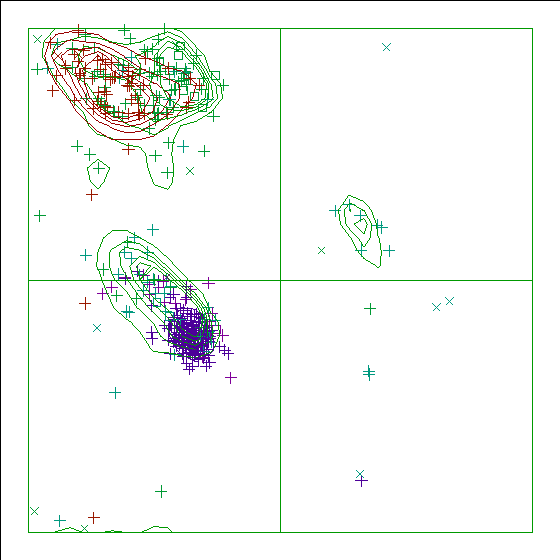
Improper dihedral RMS Z-score : 0.612
Note: Chain names are OK
All chain names assigned to polymer molecules are unique, and all
residue numbers are strictly increasing within each chain.
Note: Weights checked OK
All atomic occupancy factors ('weights') fall in the 0.0--1.0 range.
Geometric checks
Note: No missing atoms detected
All expected atoms are present.
Warning: C-terminal oxygen atoms missing
The C-atoms listed in the table below belong to a C-terminal residue
in a protein chain, but the C-terminal oxygen ("O2" or "OXT") that it
should be bound to was not found.
412 ASP ( 424 ) C
RMS Z-score for bond lengths: 0.750
RMS-deviation in bond distances: 0.017
Note: No bond length directionality
Comparison of bond distances with Engh and Huber [REF] standard
values for protein residues and Parkinson et al [REF] values for
DNA/RNA does not show significant systematic deviations.
Note: All bond angles OK
All bond angles are in agreement with standard bond angles using a
tolerance of 4 sigma (both standard values and sigma for protein
residues have been taken from Engh and Huber [REF], for DNA/RNA
from Parkinson et al. [REF]). Please note that only bond angles
within protein residues are taken into account: disulphide bridges
and peptide bonds are neglected.
Note: Normal bond angle variability
Bond angles were found to deviate normally from the mean standard
bond angles (normal values for protein residues were taken from
Engh and Huber [REF], for DNA/RNA from Parkinson et al [REF]). The
RMS Z-score given below is expected to be around 1.0 for a normally
restrained data set, and this is indeed observed for very high
resolution X-ray structures. More common values are around 1.55
RMS Z-score for bond angles: 0.915
RMS-deviation in bond angles: 1.835
Note: Side chain planarity OK
All of the side chains of residues that have a planar group are
planar within expected RMS deviations.
Note: Atoms connected to aromatic rings OK
All of the atoms that are connected to planar aromatic rings in side
chains of amino-acid residues are in the plane within expected RMS
deviations.
Warning: Unusual PRO puckering amplitudes
The proline residues listed in the table below have a puckering
amplitude that is outside of normal ranges. Puckering parameters
were calculated by the method of Cremer and Pople [REF]. Normal PRO
rings have a puckering amplitude Q between 0.20 and 0.45
Angstrom. If Q is lower than 0.20 Angstrom for a PRO residue, this
could indicate disorder between the two different normal ring forms
(with C-gamma below and above the ring, respectively). If Q is
higher than 0.45 Angstrom something could have gone wrong during the
refinement.
4 PRO ( 4 ) 0.17 LOW 191 PRO ( 196 ) 0.12 LOW 224 PRO ( 236 ) 0.16 LOW
These scores give an impression of how ``normal'' the torsion angles in protein residues are. All torsion angles except omega are used for calculating a `normality' score. Average values and standard deviations were obtained from the residues in the WHAT IF database. These are used to calculate Z-scores. A residue with a Z-score of below -2.0 is poor, and a score of less than -3.0 is worrying. For such residues more than one torsion angle is in a highly unlikely position.
225 THR ( 237 ) -2.4242 381 LEU ( 393 ) -2.3507 192 VAL ( 197 ) -2.2178 180 LEU ( 183 ) -2.1859 253 ILE ( 265 ) -2.1587 125 ARG ( 128 ) -2.0945 373 VAL ( 385 ) -2.0087
Residues with ``forbidden'' phi-psi combinations are listed, as well as residues with unusual omega angles (deviating by more than 3 sigma from the normal value). Please note that it is normal if about 5 percent of the residues is listed here as having unusual phi-psi combinations.
62 GLN ( 65 ) Poor phi/psi 155 SER ( 158 ) Poor phi/psi 158 ARG ( 161 ) Poor phi/psi 164 ASP ( 167 ) Poor phi/psi 205 LEU ( 210 ) PRO omega poor 206 PRO ( 211 ) Poor PRO-phi 217 ASN ( 229 ) Poor phi/psi 236 ASN ( 248 ) Poor phi/psi 244 LEU ( 256 ) PRO omega poor 245 PRO ( 257 ) Poor PRO-phi 263 GLY ( 275 ) Poor phi/psi 264 LYS ( 276 ) Poor phi/psi 267 LYS ( 279 ) Poor phi/psi 268 GLY ( 280 ) Poor phi/psi 308 LYS ( 320 ) Poor phi/psi 337 ALA ( 349 ) Poor phi/psi 344 VAL ( 356 ) Poor phi/psi 359 MET ( 371 ) Poor phi/psi 365 ILE ( 377 ) Poor phi/psi 368 GLY ( 380 ) Poor phi/psi 380 ALA ( 392 ) omega poor
Ramachandran Z-score : -1.582
Warning: Omega angles too tightly restrained
The omega angles for trans-peptide bonds in a structure are
expected to give a gaussian distribution with the average around
+178 degrees and a standard deviation around 5.5 degrees. These
expected values were obtained from very accurately determined
structures. Many protein structures are too tightly constrained.
This seems to be the case with the current structure, as the
observed standard deviation is below 4.0 degrees.
Standard deviation of omega values : 3.332
Note: chi-1/chi-2 angle correlation Z-score OK
The score expressing how well the chi-1/chi-2 angles of all residues
are corresponding to the populated areas in the database is
within expected ranges for well-refined structures.
chi-1/chi-2 correlation Z-score : -1.008
Note: Ramachandran plot
In this Ramachandran plot X-signs represent glycines, squares represent
prolines and small plus-signs represent the other residues. If too many
plus-signs fall outside the contoured areas then the molecule is poorly
refined (or worse).
In a colour picture, the residues that are part of a helix are shown in blue, strand residues in red. "Allowed" regions for helical residues are drawn in blue, for strand residues in red, and for all other residues in green.

Chain without chain identifier
Accessibility related checks
Note: Inside/Outside residue distribution normal
The distribution of residue types over the inside and the outside of the
protein is normal.
inside/outside RMS Z-score : 1.068
Note: Inside/Outside RMS Z-score plot
The Inside/Outside distribution normality RMS Z-score over a 15
residue window is plotted as function of the residue number. High
areas in the plot (above 1.5) indicate unusual inside/outside
patterns.
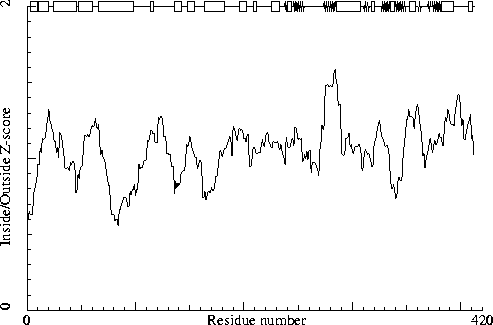
Chain without chain identifier
Secondary structure
Note: Secondary structure
This is the secondary structure according to DSSP. Only helix (H), strand
(S), turn (T) and coil (blank) are shown. [REF]
DBG> SSBOND cards to be written: 0
DBG> SSBOND cards to be written: 0
DBG> SSBOND cards to be written: 0
DBG> SSBOND cards to be written: 0
DBG> SSBOND cards to be written: 0
10 20
| |
1 - 22 MLDPNKLRNNYDFFKKKLLERN
1 - 22 HHHHHH HHHHHHHHHTT
30 40
| |
23 - 46 VNEQLLNQFIQTDKLMRKNLQQLE
23 - 46 HHHHHHHHHHHHHHHHHHHHH
50 60 70 80 90 100
| | | | | |
47 - 106 LANQKQSLLAKQVAKQKDNKKLLAESKELKQKIENLNNAYKDSQNISQDLLLNFPNIAHE
47 - 106 HHHHHHHHHHHHHTT HHHHHHHHHHHHHHHHHHHHHHHHHHHHHHHHHT T
110 120 130 140 150 160
| | | | | |
107 - 166 SVPVGKNESANLELLKEGRKPVFDFKPLPHRELCEKLNLVAFDKATKISGTRFVAYTDKA
107 - 166 TT TT333 T TT HHHHHHHTT HHHHHHHT TT HHH
170 180
| |
167 - 183 AKLLRAITNLMIDLNKS
167 - 183 HHHHHHHHHHHHHHHH
190 200 210
| | |
184 - 215 KYQEWNLPVVINELSLRSTGQLPKFKDDVFKL
184 - 215 TT HHHHHHHT TTTT333T
220 230 240 250 260 270
| | | | | |
216 - 275 ENTRYYLSPTLEVQLINLHANEIFNEEDLPKYYTATGINFRQEAGSAGKQTKGTIRLHQF
216 - 275 TTHHHHHHHTTTT SSS333 SSSSSSSSSS T TT T TSS
280 290 300 310 320 330
| | | | | |
276 - 335 QKTELVKFCKPENAINELEAMVRDAEQILKALKLPFRRLLLCTGDMGFSAEKTYDLEVWM
276 - 335 SSSSSSSSS 333HHHHHHHHHHHHHHHHHHHT SSSSS 333T TT TSSSSSSSSS
340 350 360 370 380 390
| | | | | |
336 - 395 AASNEYREVSSCSSCGDFQARRAMIRYKDINNGKNSYVATLNGTALSIDRIFAAILENFQ
336 - 395 333TSSSSSSSSSS TTHHHHHHT SSS TTT SSS SSSSSSSSSHHHHHHHHHHHT
400 410
| |
396 - 412 TKDGKILIPQALKKYLD
396 - 412 TTT TTT333
The contact distances of all atom pairs have been checked. Two atoms are said to `bump' if they are closer than the sum of their Van der Waals radii minus 0.40 Angstrom. For hydrogen bonded pairs a tolerance of 0.55 Angstrom is used. The first number in the table tells you how much shorter that specific contact is than the acceptable limit. The second distance is the distance between the centers of the two atoms.
The last text-item on each line represents the status of the atom pair. The text `INTRA' means that the bump is between atoms that are explicitly listed in the PDB file. `INTER' means it is an inter-symmetry bump. If the final column contains the text 'HB', the bump criterium was relaxed because there could be a hydrogen bond. Similarly relaxed criteria are used for 1--3 and 1--4 interactions (listed as 'B2' and 'B3', respectively). If the last column is 'BF', the sum of the B-factors of the atoms is higher than 80, which makes the appearance of the bump somewhat less severe because the atoms probably aren't there anyway.
Bumps between atoms for which the sum of their occupancies is lower than one are not reported. In any case, each bump is listed in only one direction.
2 LEU ( 2 ) CD2 -- 14 PHE ( 14 ) CE2 0.849 2.351 INTRA 286 PRO ( 298 ) CD -- 362 TYR ( 374 ) CE1 0.746 2.454 INTRA 286 PRO ( 298 ) CG -- 362 TYR ( 374 ) CE1 0.617 2.583 INTRA 145 LEU ( 148 ) CB -- 166 ALA ( 169 ) CB 0.605 2.595 INTRA 174 THR ( 177 ) CG2 -- 251 THR ( 263 ) CG2 0.586 2.614 INTRA 194 ILE ( 199 ) CG2 -- 198 SER ( 203 ) OG 0.567 2.233 INTRA 18 LEU ( 18 ) CD1 -- 23 VAL ( 25 ) CG2 0.478 2.722 INTRA 286 PRO ( 298 ) CD -- 362 TYR ( 374 ) CZ 0.404 2.796 INTRA 160 VAL ( 163 ) CG2 -- 272 LEU ( 284 ) CD1 0.399 2.801 INTRA 333 VAL ( 345 ) CG2 -- 344 VAL ( 356 ) CG2 0.358 2.842 INTRA 333 VAL ( 345 ) CG2 -- 344 VAL ( 356 ) CG1 0.323 2.877 INTRA 14 PHE ( 14 ) CE1 -- 23 VAL ( 25 ) CG1 0.303 2.897 INTRA 285 LYS ( 297 ) CE -- 287 GLU ( 299 ) OE2 0.291 2.509 INTRA 10 ASN ( 10 ) O -- 11 TYR ( 11 ) C 0.275 2.525 INTRA BF 231 ILE ( 243 ) CA -- 283 PHE ( 295 ) CZ 0.273 2.927 INTRA 143 LEU ( 146 ) O -- 145 LEU ( 148 ) CG 0.267 2.533 INTRA 21 ARG ( 21 ) O -- 22 ASN ( 22 ) CB 0.266 2.534 INTRA 296 MET ( 308 ) CE -- 376 LEU ( 388 ) CB 0.261 2.939 INTRA 285 LYS ( 297 ) CG -- 287 GLU ( 299 ) OE2 0.257 2.543 INTRA 145 LEU ( 148 ) CD2 -- 164 ASP ( 167 ) CB 0.253 2.947 INTRA 241 GLU ( 253 ) CD -- 285 LYS ( 297 ) CD 0.251 2.949 INTRA 14 PHE ( 14 ) CZ -- 18 LEU ( 18 ) CD1 0.246 2.954 INTRA 253 ILE ( 265 ) CG2 -- 255 PHE ( 267 ) CZ 0.241 2.959 INTRA 317 CYS ( 329 ) O -- 318 THR ( 330 ) C 0.238 2.562 INTRA 88 ASP ( 91 ) O -- 92 ILE ( 95 ) CG2 0.229 2.571 INTRAAnd so on for a total of 191 lines
The packing environment of the residues is compared with the average packing environment for all residues of the same type in good PDB files. A low packing score can indicate one of several things: Poor packing, misthreading of the sequence through the density, crystal contacts, contacts with a co-factor, or the residue is part of the active site. It is not uncommon to see a few of these, but in any case this requires further inspection of the residue.
125 ARG ( 128 ) -8.61 265 GLN ( 277 ) -7.06 267 LYS ( 279 ) -5.94 271 ARG ( 283 ) -5.94 112 LYS ( 115 ) -5.71 219 ARG ( 231 ) -5.46 189 ASN ( 194 ) -5.45 132 LYS ( 135 ) -5.27 21 ARG ( 21 ) -5.17 397 LYS ( 409 ) -5.16 9 ASN ( 9 ) -5.04
Average for range 1 - 412 : -0.345
Note: Quality value plot
The quality value smoothed over a 10 residue window is plotted as
function of the residue number. Low areas in the plot (below
-2.0) indicate "unusual" packing.
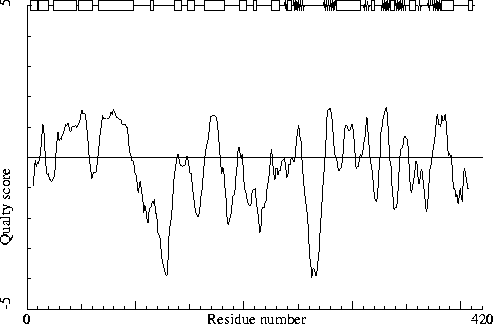
Chain without chain identifier
Warning: Low packing Z-score for some residues
The residues listed in the table below have an unusual packing
environment according to the 2nd generation quality check. The score
listed in the table is a packing normality Z-score: positive means
better than average, negative means worse than average. Only residues
scoring less than -2.50 are listed here. These are the "unusual"
residues in the structure, so it will be interesting to take a
special look at them.
267 LYS ( 279 ) -2.79 131 PHE ( 134 ) -2.76 127 PRO ( 130 ) -2.55
All contacts : Average = 0.078 Z-score = 0.67
BB-BB contacts : Average = 0.305 Z-score = 2.19
BB-SC contacts : Average = -0.196 Z-score = -0.99
SC-BB contacts : Average = 0.170 Z-score = 1.20
SC-SC contacts : Average = -0.170 Z-score = -0.62
Note: Second generation quality Z-score plot
The second generation quality Z-score smoothed over a 10 residue window
is plotted as function of the residue number. Low areas in the plot (below
-1.3) indicate "unusual" packing.
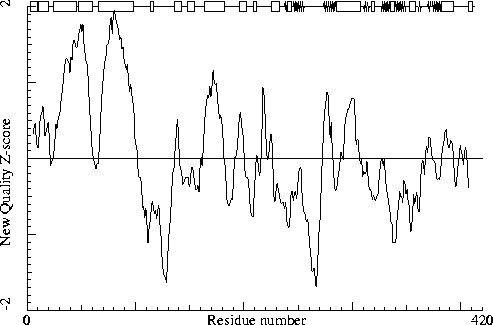
Chain without chain identifier
Note: Backbone oxygen evaluation OK
All residues for which the local backbone conformation could be
found in the WHAT IF database have a normal backbone oxygen
position.
Warning: Unusual rotamers
The residues listed in the table below have a rotamer that is not
seen very often in the database of solved protein structures. This
option determines for every residue the position specific chi-1
rotamer distribution. Thereafter it verified whether the actual
residue in the molecule has the most preferred rotamer or not. If
the actual rotamer is the preferred one, the score is 1.0. If the
actual rotamer is unique, the score is 0.0. If there are two
preferred rotamers, with a population distribution of 3:2 and your
rotamer sits in the lesser populated rotamer, the score will be
0.66. No value will be given if insufficient hits are found in the
database.
It is not necessarily an error if a few residues have rotamer values below 0.3, but careful inspection of all residues with these low values could be worth it.
377 ASN ( 389 ) 0.38 89 SER ( 92 ) 0.39 277 LYS ( 289 ) 0.39
For this check, backbone conformations are compared with database structures using C-alpha superpositions with some restraints on the backbone oxygen positions.
A residue mentioned in the table can be part of a strange loop, or there might be something wrong with it or its directly surrounding residues. There are a few of these in every protein, but in any case it is worth looking at!
155 SER ( 158 ) 0 164 ASP ( 167 ) 0 205 LEU ( 210 ) 0 264 LYS ( 276 ) 0 365 ILE ( 377 ) 0 380 ALA ( 392 ) 0 381 LEU ( 393 ) 0 165 LYS ( 168 ) 1 244 LEU ( 256 ) 1 265 GLN ( 277 ) 1 350 CYS ( 362 ) 1 359 MET ( 371 ) 1 158 ARG ( 161 ) 2
Backbone conformation Z-score : 0.124
B-factor analysis
Note: Average B-factor OK
The average B-factor of buried atoms is within expected values for
a room-temperature X-ray study.
Average B-factor for buried atoms : 22.824
Note: Number of buried atoms with low B-factor is OK
For protein structures determined at room temperature, no more than
about 1 percent of the B factors of buried atoms is below 5.0.
Percentage of buried atoms with B less than 5 : 0.00
Error: The B-factors of bonded atoms show signs of over-refinement
For each of the bond types in a protein a distribution was derived
for the difference between the square roots of the B-factors of the
two atoms. All bonds in the current protein were scored against
these distributions. The number given below is the RMS Z-score over
the structure. For a structure with completely restrained B-factors
within residues, this value will be around 0.35, for extremely high
resolution structures refined with free isotropic B-factors this
number is expected to be near 1.0. Any value over 1.5 is sign of
severe over-refinement of B-factors.
RMS Z-score : 2.061 over 2886 bonds
Average difference in B over a bond : 2.44
RMS difference in B over a bond : 6.18
Note: B-factor plot
The average atomic B-factor per residue is plotted as function of
the residue number.
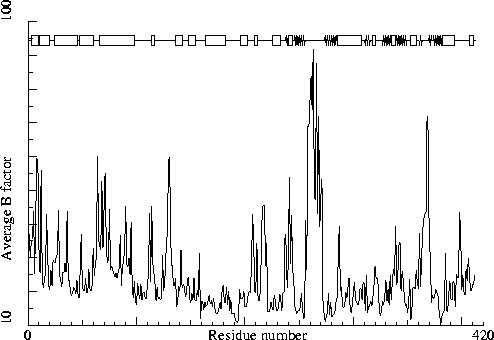
Chain without chain identifier
Hydrogen bond related checks
Error: HIS, ASN, GLN side chain flips
Listed here are Histidine, Asparagine or Glutamine residues for
which the orientation determined from hydrogen bonding analysis are
different from the assignment given in the input. Either they could
form energetically more favorable hydrogen bonds if the terminal
group was rotated by 180 degrees, or there is no assignment in the
input file (atom type 'A') but an assignment could be made. If a
residue is marked ``flexible'' the flipped conformation is only
slightly better than the non-flipped conformation.
22 ASN ( 22 ) 43 GLN ( 45 ) 77 GLN ( 80 ) 186 GLN ( 191 ) 229 GLN ( 241 ) 234 HIS ( 246 ) 405 GLN ( 417 )
In the table below all normal histidine residues are listed. The assignment based on the geometry of the residue is listed first, together with the RMS Z-score for the fit to the Engh and Huber parameters. For all residues where the H-bond assignment is different, the assignment is listed in the last columns, together with its RMS Z-score to the Engh and Huber parameters.
As always, the RMS Z-scores should be close to 1.0 if the residues were restrained to the Engh and Huber parameters during refinement.
Please note that because the differences between the geometries of the different types are small it is possible that the geometric assignment given here does not correspond to the type used in refinement. This is especially true if the RMS Z-scores are much higher than 1.0.
If the two assignments differ, or the ``geometry'' RMS Z-score is high, it is advisable to verify the hydrogen bond assignment, check the HIS type used during the refinement and possibly adjust it.
105 HIS ( 108 ) HIS-E 0.85 136 HIS ( 139 ) HIS-D 0.69 234 HIS ( 246 ) HIS-D 0.72 HIS-E 0.86 273 HIS ( 285 ) HIS-D 0.76
Hydrogen bond donors that are buried inside the protein normally use all of their hydrogens to form hydrogen bonds within the protein. If there are any non hydrogen bonded buried hydrogen bond donors in the structure they will be listed here. In very good structures the number of listed atoms will tend to zero.
1 MET ( 1 ) N 11 TYR ( 11 ) N 49 ASN ( 52 ) N 104 ALA ( 107 ) N 113 ASN ( 116 ) N 117 ASN ( 120 ) N 137 ARG ( 140 ) N 146 VAL ( 149 ) N 159 PHE ( 162 ) N 181 ASN ( 184 ) ND2 188 TRP ( 193 ) NE1 193 VAL ( 198 ) N 207 LYS ( 212 ) N 213 PHE ( 218 ) N 217 ASN ( 229 ) N 218 THR ( 230 ) N 220 TYR ( 232 ) N 226 LEU ( 238 ) N 229 GLN ( 241 ) N 246 LYS ( 258 ) NZ 254 ASN ( 266 ) ND2 269 THR ( 281 ) N 274 GLN ( 286 ) N 278 THR ( 290 ) OG1 298 ARG ( 310 ) NE 312 ARG ( 324 ) NE 313 ARG ( 325 ) NE 328 THR ( 340 ) N 334 TRP ( 346 ) NE1 336 ALA ( 348 ) N 340 GLU ( 352 ) N 341 TYR ( 353 ) N 342 ARG ( 354 ) NE 354 GLN ( 366 ) N 355 ALA ( 367 ) N 357 ARG ( 369 ) NE 357 ARG ( 369 ) NH2 365 ILE ( 377 ) N 369 LYS ( 381 ) N 384 ASP ( 396 ) N 408 LYS ( 420 ) N
Side-chain hydrogen bond acceptors that are buried inside the protein normally form hydrogen bonds within the protein. If there are any not hydrogen bonded in the optimized hydrogen bond network they will be listed here.
65 ASN ( 68 ) OD1 234 HIS ( 246 ) ND1 241 GLU ( 253 ) OE2 254 ASN ( 266 ) OD1 370 ASN ( 382 ) OD1 393 ASN ( 405 ) OD1
The second part of the table mostly gives an impression of how well the model conforms to common refinement constraint values. The first part of the table shows a number of constraint-independent quality indicators.
Structure Z-scores, positive is better than average:
1st generation packing quality : 0.387 2nd generation packing quality : 0.665 Ramachandran plot appearance : -1.582 chi-1/chi-2 rotamer normality : -1.008 Backbone conformation : 0.124
Bond lengths : 0.750 Bond angles : 0.915 Omega angle restraints : 0.606 (tight) Side chain planarity : 0.074 (tight) Improper dihedral distribution : 0.612 B-factor distribution : 2.061 (loose) Inside/Outside distribution : 1.068